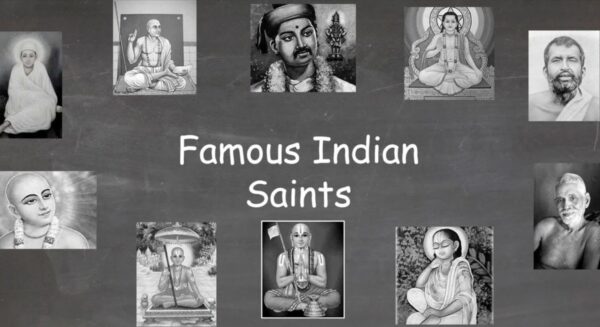India is renowned in its holy sacraments and philosophical beliefs which have transformed the world and assisting people in becoming more successful version of their own. There are many saints who emerged during various periods of our country, and a lot of people have embraced their beliefs and become their fervent followers. These are the ten most notable saints from India who’s ideas and beliefs are considered to be appropriate for every time.
Also Read: Top 10 Famous Indian Transgender
Top 10 Famous Indian Saints of all Time
1. Ramanuja:
Ramanuja is considered to be one of the founding members within the Bhakti movement. He is regarded as one of the most revered followers of his guru yamunamuni. The saint has traveled across the country, and finally settled in the capital city Srirangam located in Tamilnadu. He is credited with having set up Vaishnavism with a solid base. He is believed to have established the Visistadvaita Siddhanta and been able to be a monism. According to his philosophies the only way to attain salvation is by following those principles that are Karma, Bhakti and Gyan. He is also believed for having written his works, the Gitbhasya along with the Sribasya.
2. Chaitanya:
Chaitanya was among the greatest saints of Bhakti movement. The place he was raised is Nawadwip located in Bengal and was formerly called Vishwambhar Mishra. He is among the most revered saints, who were responsible for spreading Vaishnaviwm across Bengal and gained fame with the aid through his Kirtans. He is also believed to have established the School of Theology in Bengal and also preached about the spirituality of intense faith alongside Hari. This saintly saint loved Gods Krishna along with Radha and attempted to make their lives more spiritual within the sacred city of Vrindavan. He passed away in Puri which is where he stayed for the rest of his life. Following his death, his followers established his teachings in a systematic manner, and he published his biography, titled Chaitanya Charitamrita.
3. Shirdi Sai Baba
Sai Baba of Shirdi was a famous Indian holy man and spiritual teacher adored to the utmost by Muslim and Hindu followers. According to his life, it is possible to discern that he preached the importance of realizing the self of oneself and strongly criticized the love of human beings towards things that are perishable. His lectures and sermons were focused in forgiveness and love of one another as well as helping others as well as inner peace, contentment and devotion to God. He strongly opposed discrimination based on religion and caste. The people who worship him consider him as the incarnation of the Hindu God Dattatreya.
4. Tulsidas:
Tulsidas is a Vaishnava poet and saint who has devoted his life to the god Rama. He is famous for his writing several pieces in Sanskrit and his most famous piece can be described as Hanuman Chalisa. Tulsidas lived the majority of his time within the city of Banaras as well as Ayodhya. He established his own Sankat Mochan Hanuman Temple in Varanasi and is believed to be in the first place he saw the god. Tulsidas established his own Ramlila Plays, a folk stage version of the epic poem Ramayana. He is regarded as one of the top poets of Hindi, Indian, and the world literature. Tulsidas and his work have had a broad influence on Indian culture, art and society according to the language of the day, which is called vernacular.
5. Surdas:
Surdas was a blind Hindu worshipful poet and singer known for his poems in praise of Krishna. His poems expressed his devotion to Krishna. The majority of his poetry were composed in Braj however, there were some written as other Hindi dialects, including Awadhi. His life is typically described through the lens of the Vallabha Smaradaya which is also known in the Pustimarga. The Pustimarga examines Pustimarga rituals of singing and worship that rely upon Surdas as well as others Astachap poets’ works. Modern academics study the connection to Surdas as well as Vallabha.
6. Kabir:
Born in Benaras He lived the normal life of a family man. The purpose of his Ramananda devotee was to spread an ideology of love which could unite individuals of every creed and caste. He stressed the unity of God and uses a variety of names, such as Rama, Hari, and Allah. He was adamantly against Hindu as well as Muslim practices. He was adamantly opposed to casting system and specifically the practice of non-touchability. But he was no social reformer, instead, he focused on personal improvement under the guidance of an esoteric Guru. Dohas and sakhi poetry can be found in Bijak. After Kabir’s death Muslim followers formed themselves in Maghar and Surat Gopala. Surat Gopala gathered the Hindu followers into an organisation with its headquarters in Banaras.
7. Ramakrishna Paramahansa
Shri Ramakrishna Paramahansa was born on February 18, 1836 in the tiny village of Kamarpukur which was located several miles from Kolkata and belonged to a petty Brahmin family. Gadadhar was his name for his youth was a favorite among the villager. He is regarded as the most revered saint of the 19th century. The saint was an eminent mystic as well as a true yoga practitioner. He adored Goddess Kali and believed himself to be an modern-day version of Lord Vishnu however, the guru never declared the existence of this.
8. Guru Nanak
Sri Guru Nanak Dev Ji was the first Guru of Sikhism that is believed to be an monotheistic faith with Muslim as well as Hindu roots. His teachings, which are reflected in the devotional hymns, a lot of which remain in existence that emphasized the reincarnation of oneself by meditating on the divine name. He is particularly revered by contemporary Sikhs as the creator and the greatest expert of Punjabi devotional hymnody.
9. Guru Gobind Singh
Guru Gobind Singh, the nineteenth and last Sikh Guru. He was the ninth and final Sikh Guru. He was a poet, warrior and philosopher. After the Emperor Aurangzeb murdered his father Guru Tegh Bahadur, the Sikh Guru was officially appointed the head of the Sikhs in 1675, at age nine. One of his most significant contributions to Sikhism was the creation of the Sikh warrior group, known as Khalsa in 1699, and the creation of the Five Ks, the five religious articles which were worn by Khalsa Sikhs all the time.
10. Mahavira
Mahavira was the guru of Jainism and was the 25th Tirthankara (Supreme teacher). Mahavira is the spiritual successor of his 23rd Tirthankara, Parshvanatha. Mahavira was born during the sixth century BCE into an elite royalty Jain family from the ancient India. His parents are Trishala as well as Siddhartha. They were devotees who remained in the cult of the Parshvanatha. Around 30years old, Mahavira left all material things and left his home in pursuit for spiritual awakening. He eventually being an ascetic. Mahavira was a meditative guru and intense austerities for 12 and a half months before reaching Kevala Jnana (omniscience).
It is believed that the Indian subcontinent has been blessed with many saints aside from this list that have contributed to the history of the Indian subcontinent and a remarkable set of teachings for the world. All saints are humanists and their teachings help improve the quality of the community.



